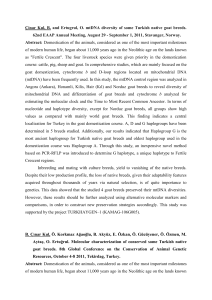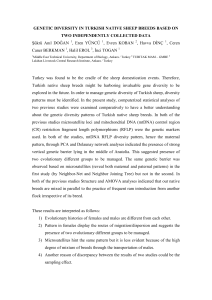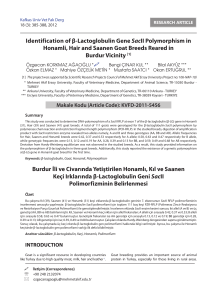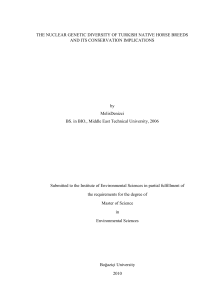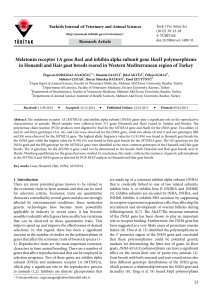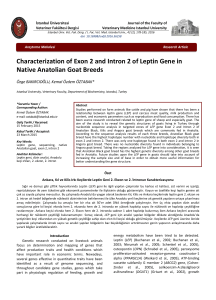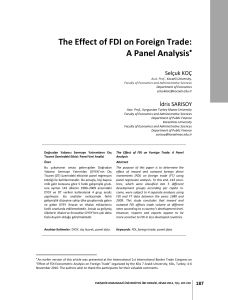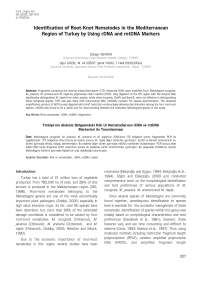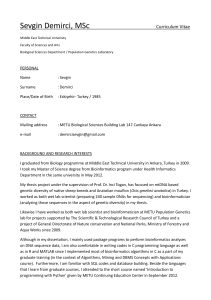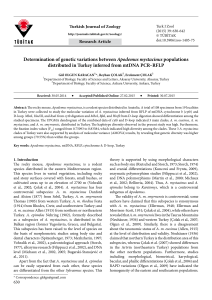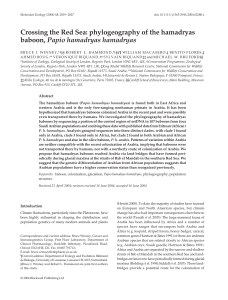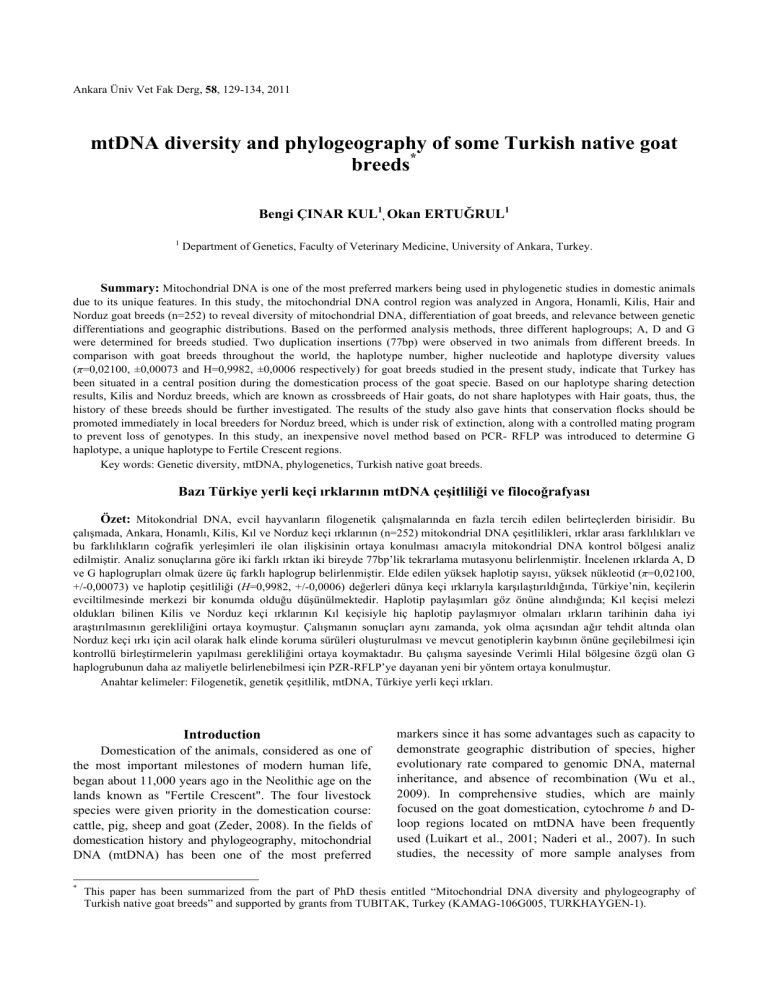
Ankara Üniv Vet Fak Derg, 58, 129-134, 2011
mtDNA diversity and phylogeography of some Turkish native goat
breeds*
Bengi ÇINAR KUL1, Okan ERTUĞRUL1
1
Department of Genetics, Faculty of Veterinary Medicine, University of Ankara, Turkey.
Summary: Mitochondrial DNA is one of the most preferred markers being used in phylogenetic studies in domestic animals
due to its unique features. In this study, the mitochondrial DNA control region was analyzed in Angora, Honamli, Kilis, Hair and
Norduz goat breeds (n=252) to reveal diversity of mitochondrial DNA, differentiation of goat breeds, and relevance between genetic
differentiations and geographic distributions. Based on the performed analysis methods, three different haplogroups; A, D and G
were determined for breeds studied. Two duplication insertions (77bp) were observed in two animals from different breeds. In
comparison with goat breeds throughout the world, the haplotype number, higher nucleotide and haplotype diversity values
(π=0,02100, ±0,00073 and H=0,9982, ±0,0006 respectively) for goat breeds studied in the present study, indicate that Turkey has
been situated in a central position during the domestication process of the goat specie. Based on our haplotype sharing detection
results, Kilis and Norduz breeds, which are known as crossbreeds of Hair goats, do not share haplotypes with Hair goats, thus, the
history of these breeds should be further investigated. The results of the study also gave hints that conservation flocks should be
promoted immediately in local breeders for Norduz breed, which is under risk of extinction, along with a controlled mating program
to prevent loss of genotypes. In this study, an inexpensive novel method based on PCR- RFLP was introduced to determine G
haplotype, a unique haplotype to Fertile Crescent regions.
Key words: Genetic diversity, mtDNA, phylogenetics, Turkish native goat breeds.
Bazı Türkiye yerli keçi ırklarının mtDNA çeşitliliği ve filocoğrafyası
Özet: Mitokondrial DNA, evcil hayvanların filogenetik çalışmalarında en fazla tercih edilen belirteçlerden birisidir. Bu
çalışmada, Ankara, Honamlı, Kilis, Kıl ve Norduz keçi ırklarının (n=252) mitokondrial DNA çeşitlilikleri, ırklar arası farklılıkları ve
bu farklılıkların coğrafik yerleşimleri ile olan ilişkisinin ortaya konulması amacıyla mitokondrial DNA kontrol bölgesi analiz
edilmiştir. Analiz sonuçlarına göre iki farklı ırktan iki bireyde 77bp’lik tekrarlama mutasyonu belirlenmiştir. İncelenen ırklarda A, D
ve G haplogrupları olmak üzere üç farklı haplogrup belirlenmiştir. Elde edilen yüksek haplotip sayısı, yüksek nükleotid (π=0,02100,
+/-0,00073) ve haplotip çeşitliliği (H=0,9982, +/-0,0006) değerleri dünya keçi ırklarıyla karşılaştırıldığında, Türkiye’nin, keçilerin
evciltilmesinde merkezi bir konumda olduğu düşünülmektedir. Haplotip paylaşımları göz önüne alındığında; Kıl keçisi melezi
oldukları bilinen Kilis ve Norduz keçi ırklarının Kıl keçisiyle hiç haplotip paylaşmıyor olmaları ırkların tarihinin daha iyi
araştırılmasının gerekliliğini ortaya koymuştur. Çalışmanın sonuçları aynı zamanda, yok olma açısından ağır tehdit altında olan
Norduz keçi ırkı için acil olarak halk elinde koruma sürüleri oluşturulması ve mevcut genotiplerin kaybının önüne geçilebilmesi için
kontrollü birleştirmelerin yapılması gerekliliğini ortaya koymaktadır. Bu çalışma sayesinde Verimli Hilal bölgesine özgü olan G
haplogrubunun daha az maliyetle belirlenebilmesi için PZR-RFLP’ye dayanan yeni bir yöntem ortaya konulmuştur.
Anahtar kelimeler: Filogenetik, genetik çeşitlilik, mtDNA, Türkiye yerli keçi ırkları.
Introduction
Domestication of the animals, considered as one of
the most important milestones of modern human life,
began about 11,000 years ago in the Neolithic age on the
lands known as "Fertile Crescent". The four livestock
species were given priority in the domestication course:
cattle, pig, sheep and goat (Zeder, 2008). In the fields of
domestication history and phylogeography, mitochondrial
DNA (mtDNA) has been one of the most preferred
*
markers since it has some advantages such as capacity to
demonstrate geographic distribution of species, higher
evolutionary rate compared to genomic DNA, maternal
inheritance, and absence of recombination (Wu et al.,
2009). In comprehensive studies, which are mainly
focused on the goat domestication, cytochrome b and Dloop regions located on mtDNA have been frequently
used (Luikart et al., 2001; Naderi et al., 2007). In such
studies, the necessity of more sample analyses from
This paper has been summarized from the part of PhD thesis entitled “Mitochondrial DNA diversity and phylogeography of
Turkish native goat breeds” and supported by grants from TUBITAK, Turkey (KAMAG-106G005, TURKHAYGEN-1).
Bengi Çınar Kul - Okan Ertuğrul
130
domestication centers such as Turkey has been
emphasized since molecular studies carried out on
domestic livestock animals have obviously revealed that
these species have distributed to European zones across
Anatolia (MacHugh and Bradley, 2001; Naderi et al.,
2008; Zeder, 2008).
Turkish native goat breeds, have an important
position in domestication history, besides they are
valuable genetic resources for the ecosystem and
economy. Uptodate, there is not much comprehensive
and instructive data accumulated regarding the
mitochondrial diversity and maternal background of
these breeds. In this study, it is aimed to unveil the
domestication history of the goat and to explain the
mtDNA diversity and phylogeographic structure of these
breeds. For this purpose, D-loop and cytochrome b
regions was sequenced and analyzed from the Angora,
Honamli, Kilis, Hair and Norduz goat breeds.
Materials and Methods
Sampling and DNA isolation procedures: A total of
252 blood samples of goats were collected from 5
Turkish native goat breeds on the natural habitat (Figure
1). To represent the genetic diversity in a reliable
manner, samples from the breeds have been collected
from subjects of distant zones, which are not bloodrelated. Gender and breed properties have been taken into
consideration and geographical locations have also been
properly recorded. After sampling procedure, mtDNA
was extracted by phenol/chloroform method as described
previously (Sambrook et al., 1989) and extracted DNA
concentrations were adjusted to 50-100 ng/µL for PCR
amplification.
PCR was performed in a 25 µl reaction mixture
containing 100 ng of genomic DNA, 2 mM MgCl2, 5
pmol of each primer, 200 µM of each dNTP, 1U Taq
DNA polymerase (MBI Fermentas) and 1X PCR buffer
(10 mM Tris-HCl, pH 9,0; 50 mM KCl) by using
Mastercycler thermal cycler (Eppendorf AG, USA) under
the following conditions: first denaturation for 4 min at
94°C followed by 30 cycles of 30 s denaturation at 94°C,
30 s primer annealing at 64°C and 70 s extension at 72°C
with final extension 15 min at 70°C. The PCR products
were run through 2% (w/v) agarose gel electrophoresis
under 120V for 20 min and then amplicons were purified
on spin columns according to the manufacturer's
instructions (QIAquick PCR Purification Kit, Qiagen).
Two internal primers (CAP-F and CAP-R) including
Hypervariable region-1 (HV-1) were used for sequencing
as previously described by Naderi et al (2007).
Within each breed, cytochrome b regions were
amplified by L14724V and Chir_Cyto1R primers to the
samples classified to different haplogroups based on their
D-loop regions, in order to further investigate the
introgression time. Amplifications with the outer primers
have been performed under the same conditions and
chemical concentrations mentioned above except for the
annealing temperature to be 59°C. Table 1 summarizes
the used primers and their nucleotide sequences.
Following the PCR purifications, all PCR products were
sequenced directly on both strands by using an ABI 3130
autoanalyzer (Applied Biosystems, Foster City, CA,
USA).
Table 1. Sequences of the used primers.
Tablo 1. Kullanılan primerlere ait diziler.
Region
Primer
Typing-2-F
CAP-F*
D-loop
CAP-R*
Typing-1-R
L14724V*
Chir_Cyto1intF*,+
Chir_Cyto1intR*,+
Sequence, 5’Æ 3’
CCTCACTATCAGCACC
CAAAG
CGTGTATGCAAGTACA
TTAC
CTGATTAGTCATTAGT
CCATC
CTACAATTTATGCTCC
GGGTC
ATGATATGAAAAACCA
TCGTT
CCTCCTGCTCGCAACA
ATGG
ATGGGATTGCTGAAAG
AAGA
TACTATTCACACCCGA
CCTA
TTGGGGATTGATCGTA
GGATT
GGCTATTCTCCTTTTCT
GGTT
Figure 1. The localization of sampled provinces in the
geographical Turkey map; yellow circle is Angora, red circle is
Honamli, pink circle is Kilis, blue circle is Norduz goat breeds.
Şekil 1. Türkiye fiziki haritası üzerinde örnekleme bölgelerinin
konumları (Ankara sarı, Honamlı kırmızı, Kıl turkuaz, Kilis
pembe ve Norduz mavi daire ile gösterilmiştir).
Cytochrome b
Amplification and sequencing: The complete Dloop was amplified by using forward primer Typing-2-F
and reverse primer Typing-1-R (Sultana et al., 2003).
* Primers used for sequencing; + Primers designed in the present
study.
*Dizi analizinde kullanılan pimerler; + yeni tasarlanan primerler.
Chir_Cyto2intF*,+
Chir_Cyto2intR*,+
Chir_Cyto1R*,+
Ankara Üniv Vet Fak Derg, 58, 2011
Data and phylogenetic analyses: The nucleotide
sequences were aligned and edited by using BioEdit
Version7.0.9.1 (Hall, 1999). Gaps in the aligned
sequences were excluded from the following analyses.
Further analyses were performed using 453bp for D-loop
region and 1148 bp for cytochrome b region. The
polymorphisms in the analyzed regions, nucleotide
diversity (π), haplotype diversity (h) and their standard
deviation values for the breeds were estimated by using
DnaSP v5 software (Librado and Rozas, 2009).
Maximum-likelihood (ML) tree was created by using
PhyML v3.0 (Guindon and Gascuel 2003) with GTR
model and aLRT test. To identify possible phylogenetic
clades, Neighbor-Joining (NJ) tree was firstly
constructed by using K2P model with pairwise deletion
(1,000 replicates) with MEGA 4.0 software (Kumar et
al., 2008) and classified to the clades according to the
reference sequences described previously by Naderi et al.
(2007). Since mtDNA is a haploid, differentiation
between populations was assessed by sequence-based F
statistics using MEGA 4.0 (Kumar et al., 2008) and
distances tree was constructed with PHYLIP 3.69
(Felsenstein, 2005) and TreeView (Page, 1996)
softwares. The statistical significance of the correlation
between geographic and genetic distance matrices based
on mtDNA data between breeds, was evaluated by the
Mantel test and additionally, AMOVA statistics were
used to show the hierarchical proportions of variance.
Both analyses were performed by using Arlequin
ver3.5.1.2 (Excoffier and Lischer, 2010). D-loop region
sequences of C. aegagrus (EF989163, EF989426)
(Naderi et al., 2008), C. caucasica (AJ317875), C.
sibirica (AJ317874), C. cylindricornis (AJ317870), C.
nubiana (AJ317871) and C. falconeri (AJ317872)
(Luikart et al., 2001) and O. aries (AM279285) (Fajardo
et.al., 2007) as an out group were used in order to
enlighten the relation with wild goat.
Population history: A Median-joining network was
generated to further investigate the possible relationships
among the lineages by the program Network v.4.516
(Bandelt et al., 1999) to visualize the relationships
among haplotypes of all samples. To test the neutral
theory, DnaSP v5 was used (Librado and Rozas, 2009) to
131
calculate Tajima's D (Tajima, 1989) and Fu's Fs (Fu,
1996). Cytochrome b was used to estimate the molecular
clock and the Time to Most Recent Common Ancestor,
TMRCA. For this purpose, Minimum Evolutionary Tree
was constructed by using the sequence of samples from
different haplogroups and O. aries under MEGA 4.0
(Kumar et al., 2008) program and Maximum Composite
Likelihood method. Nei’s method (D=2urt) was used to
estimate the age of the phylogenetic clades.
mt-lineage typing: In this study the new mt-lineage
typing for G haplogroup was described by using a PCR
restriction fragment length polymorphism (PCR-RFLP)
method based on A→G transition at nucleotide position
16071 in the D-loop (A16071G). A specific segment of
mtDNA was amplified using outer D-loop region
primers. The amplified DNA was digested overnight at
37°C with the Bsp681 (NruI) (MBI Fermentas). Products
were run on 2% agarose gel.
Results
Structure of the populations: Statistical data
regarding the mtDNA diversity in studied breeds is
shown in Table 2. A total of 208 haplotypes were
identified within 252 goat samples and 174 of them were
unique. Duplication insertions (77bp) observed on D-loop
regions of two individuals from different breeds were
quite remarkable.
Phylogenetic relations of the individuals were
investigated by NJ and ML tree constructions assuming a
gamma distribution parameter of α=0,349 and the
individuals were classified to haplogroups by the means
of reference sequences (Figure 2). Based on these
analyses, 245 of the animals were classified in
Haplogroup A, which is thought to be the oldest
haplogroup. Similarly, an Angora, a Kilis and four
Honamli goats were classified in Haplogroup G and one
Kilis goat is classified in Haplogroup D. One of the Kilis
goats from Haplogroup D was identified on the same
branch with a C. aegagrus (EF989426) and a Kilis and
Hair goat from Haplogroup A were identified on the
same branch with another C. aegagrus (EF989163)
(Figure 2).
Table 2. Some statistical highlights about the studied breeds.
Tablo 2. İncelenen ırklarla ilgili bazı istatistiki değerler.
Breed
N
Nh
h ± sd
Angora
Honamli
Kilis
Hair
Norduz
50
49
51
53
49
42
42
48
48
36
0,993; ± 0,005
0,993; ± 0,006
0,998; ± 0,004
0,996; ± 0,005
0,983; ± 0,008
π ± sd
0,0202;± 0,00162
0,0233;± 0,00187
0,0205;± 0,00188
0,0203;± 0,00108
0,0192;± 0,00101
Total
252
208
0,9982; ± 0,0006
0,0210;± 0,00073
Fu’s Fs
Tajima’s D
-32,968
-29,266
-47,991*
-44,975
-20,170
-1,57723*
-1,25471
-1,85794**
-1,46930
-1,30735
*,P < 0,10; **, P < 0,05
N: Number of sampled individuals, Nh: Number of haplotypes, h: Haplotype diversity, sd: Standart deviation, π: Nucleotide diversity.
N:Örneklenen birey sayısı, Nh: Haplotip sayısı, h: Haplotip çeşitliliği, sd: Standart sapma, π: Nükleotit çeşitliliği.
132
Bengi Çınar Kul - Okan Ertuğrul
Figure 2. Maximum Likelihood tree of 252 individuals constructed under GTR model and aLRT test.
Şekil 2. GTR modeli ve aLRT testi kullanılarak oluşturulan ML ağacı.
Figure 3. A. NJ tree constructed on FST distances of all the
breeds plus wild goats and O. aries as an out group. B. NJ tree
of FST distances of the studied breeds only.
Şekil 3.A.Tüm ırklar, yaban keçileri ve dış grup olarak koyun
kullanılarak FST uzaklıklarına gore NJ ağacı. B. Sadece
incelenen ırklara ait FST uzaklığı için NJ ağacı.
Figure 4. MJ network analysis of all haplotypes.
Şekil 4. Tüm haplotiplere ait Median-Joining networkü.
According to pairwise FST distances, all breeds have
been involved on the same branch with C. aegagrus
(Figure 3.A). Pairwise FST comparisons also showed that
there is a low genetic differentiation between Hair and
Honamli goats and likewise between Kilis and Norduz
goats. Norduz and Honamli goats have also a mild
genetic differentiation between each other. (0,045; p <
0,001) (Figure 3.B). All phylogenetic trees demonstrated
similar branching patterns for breeds and analyzed data
showed that a breed-specific localization or distribution
was not present.
To estimate the correlation between geographic and
genetic distances matrices an experimental setup in
which Kilis and Norduz goats were considered in the
same group, Honamli and Hair goats were considered in
another and Angora breed was considered as a separate
group was designed. In this particular design, ΦCT value
was estimated quite high (71,15) (data not shown).
According to Mantel test results, a strong relation (0,75;
p<0,05) between geographic and genetic distances was
observed.
History of the populations: Fu’s Fs and Tajima’s D
values are provided on Table 3. Median Joining network
obtained from haplotypic data showed that all haplotypes
condensed around a centric area, each sequence
represented almost a specific haplotype and Haplogroup
A has a star-like pattern (Figure 4). The TMRCA based
on cytochrome b distances for Haplogroups A, D and G
was calculated to be 168,000 years and G was found to
be the oldest haplogroup among all. For the
determination of this haplogroup, a novel method was
introduced. In this wise, two segments with 691 and 311
bp were harvested via an enzymatic digestion process of
a 1002 bp D-loop region obtained by amplification with
outer primers (Figure 5).
Ankara Üniv Vet Fak Derg, 58, 2011
Figure 5. The PCR-RFLP analysis for typing Haplogroup G.
Lane G is Haplogroup G, Lane A is Haplogroup A and Lane M
is 100bp DNA ladder (MBI Fermentas).
Şekil 5. G-haplogrubu belirlemede PCR-RFLP analizi. G sırası
G haplogrubunu, A sırası A haplogrubunu, M sırası ise 100bp
DNA ladderi (MBI Fermentas) göstermektedir.
Discussion and conclusion
Domestic goat (C. hircus) is thought to originate
from wild goat species C. aegagrus, C. falconeri, C.
prisca, C. ibex and C. caucasica with respect to their
horn morphology and distribution profile (Batu, 1951). In
the present study; our results demonstrated that 5 of the
Turkey’s native goat breeds originated from C. aegagrus
(bezoar), in accordance with the findings of Mannen et
al. (2001). C. prisca is an extinct group, so we did not
have the chance of a molecular comparison for this
specie. It is of particular interest that two members of
Kilis breed from Fertile Crescent region have highly
similar sequence profile with two wild goats, thus,
possessing ancient haplotypes.
Two of the main factors to determine the
domestication zones are nucleotide and haplotide
diversity. In circumstances where selection and isolation
is ruled out, diversity is expected to reduce as distance
from the domestication zone increases, since, groups
which are being moved out of the genetic pool could only
carry a limited number of genotypes (Loftus et al., 1999;
MacHugh and Bradley, 2001). The estimated diversity
indices suggest that Kilis goat breed exhibits the highest
diversity. In terms of nucleotide and haplotype diversity,
except for Norduz goat breeds, all groups show high
values as compared with mainly world goat breeds
(Luikart et al., 2001; Joshi et al., 2004; Pereira et al.,
2005; Naderi et al., 2007). This finding indicates a
central localization for Turkey in the goat domestication
course, in accordance with the findings of Naderi et al.
(2008).
133
A, D and G haplogroups have been determined in 5
breeds studied. Haplogroups B and C, often recognizable
in Asian countries, were not found in this study. This can
be attributable to introgression times and human
migration routes. Based on the assumption that Angora
goat breed have been transported from Central Asia
(Akçapınar, 1994), one can speculate that these
haplogroups could have been introduced to the
population at a later time zone than the migration of
Angora goats’ ancestors from Central Asia to Anatolia,
or, ancestor lineages of Central Asia could have deceived
their B and C haplogroups after their arrival at Anatolia.
Based on neutrality test findings, Kilis goat breed seems
to have an expansion of population and accretion of new,
low frequency haplotypes. However, when considered
that Kilis and Norduz breeds do not share a common
haplotype with Hair goat breed, the claim that these
breeds are Hair goat crossbreeds (Yalçın, 1986; Porter,
1996), may need a further ascertainment in terms of
breed backgrounds. Additionally, our results indicated
that Haplogroup G is the most ancient haplogroup for
Turkish native goat breeds and oldest haplogroup used in
the domestication course was Haplogroup A. Besides, a
novel, cost and time-effective method for the determination
of Haplogroup G is introduced in this study.
Inbreeding and mating with culture breeds, yield to
vanishing of the native breeds. Despite their low delivery
profile, the loss of native breeds, given their adaptability
features acquired throughout thousands of years via
natural selection such as resistance to illnesses and
adaptation capabilities to ambient conditions, is of quite
importance to genetics. This data showed that the studied
breeds preserved their mtDNA diversities. However,
these results should be further analyzed using alternative
molecular markers and comparisons, in order to construct
new preservation strategies accordingly. Furthermore,
collaboration with other scientists such as archeologists
and a providing a multidisciplinary perspective is a must
for the accurate determination of time points in the
assessment of population history.
Acknowledgements
The authors wish to thank TURKHAYGEN–1
(In Vitro Conservation and Preliminary Molecular
Identification of Some Turkish Domestic Animal Genetic
Resources-I; KAMAG-106G005) Project staff.
References
1.
2.
Akçapınar H (1994): Keçi Yetiştiriciliği Ders Notları.
Ankara Üniversitesi Veteriner Fakültesi Zootekni Anabilim
Dalı.
Bandelt HJ, Forster P, Röhl A (1999): Median-joining
networks for inferring intraspecific phylogenies. Mol Biol
Evol, 16, 37-48.
134
3.
4.
5.
6.
7.
8.
9.
10.
11.
12.
13.
14.
15.
16.
Bengi Çınar Kul - Okan Ertuğrul
Batu S (1951): Türkiye Yerli Keçi Irkları ve Keçi
Yetiştirme Bilgisi. Ankara Üniversitesi Veteriner Fakültesi
Kitabı No:2.
Excoffier L, Lischer HEL (2010): Arlequin suite ver 3.5:
A new series of programs to perform population genetics
analyses under Linux and Windows. Mol Ecol Resour, 10,
564-567.
Fajardo V, Gonzalez I, Lopez-Calleja I, Martin I, Rojas
M, Pavon MA, Garcia T, Hernandez PE, Martin R
(2007): PCR identification of meats from chamois
(Rupicapra rupicapra), pyrenean ibex (Capra pyrenaica),
and mouflon (Ovis ammon) targeting specific sequences
from the mitochondrial D-loop region. Meat Sci, 76, 644652.
Felsenstein J (2005): PHYLIP version 3.6. Distributed by
the author. Department of Genome Sciences, University of
Washington, Seattle.
Fu YX (1997): Statistical tests of neutrality of mutations
against population growth, hitchhiking and background
selection. Genetics, 147, 915–925.
Guindon S, Gascuel O (2003): A simple, fast, and
accurate algorithm to estimate large phylogenies by
maximum likelihood. Syst Biol, 52, 696-704.
Hall TA (1999): BioEdit:a user-friendly biological
sequence alignment editor and analysis program for
Windows 95/98/NT. Nucl Acids Symp, 41, 95-98.
Joshi MB, Rout PK, Mandal AK, Tyler-Smith C, Singh
L, Thangaraj K (2004): Phylogeography and origin of
Indian domestic goats. Mol Biol Evol, 21, 454-462.
Kumar S, Dudley J, Nei M, Tamura K (2008): MEGA:
A biologist-centric software for evolutionary analysis of
DNA and protein sequences. Brief Bioinform, 9, 299-306.
Librado P, Rozas J (2009): DnaSP v5: A software for
comprehensive analysis of DNA polymorphism data.
Bioinformatics, 25, 1451-1452.
Loftus RT, Ertugrul O, Harba AH, El-Barody MA,
Machugh DE, Park SD, Bradley DG (1999): A
microsatellite survey of cattle from a centre of origin: the
Near East. Mol Ecol, 8, 2015-2022.
Luikart G, Gielly L, Excoffier L, Vigne J-D, Bouvet J,
Taberlet P (2001): From the Cover: Multiple maternal
origins and weak phylogeographic structure in domestic
goats. PNAS, 98, 5927-5932.
MacHugh DE, Bradley DG (2001): Livestock genetic
origins: Goats buck the trend. PNAS, 98, 5382-5384.
Mannen H, Nagata Y, Tsuji S (2001): Mitochondrial
DNA reveal that domestic goat (Capra hircus) are
genetically affected by two subspecies of Bezoar (Capra
aegagrus). Biochem Genet, 39, 145-454.
17. Naderi S, Rezaei HR, Taberlet P, Zundel S, Rafat SA,
Naghash HR, Elbarody MAA, Ertugrul O, Pompanon
F (2007): Large-scale mitochondrial DNA analysis of the
domestic goat reveals six haplogroups with high diversity.
PLoS ONE, 2,10, e1012.
18. Naderi S, Rezaei HR, Pompanon F, Blum MG, Negrini
R, Naghash HR, Balkiz O, Mashkour M, Gaggiotti OE,
Ajmone-Marsan P, Kence A, Vigne JD Taberlet P
(2008): The goat domestication process inferred from
large-scale mitochondrial DNA analysis of wild and
domestic individuals. PNAS, 105, 17659-17664.
19. Pereira F, Pereira L, Van Asch B, Bradley DG,
Amorim A (2005): The mtDNA catalogue of all
Portuguese autochthonous goat (C. hircus) breeds: high
diversity of female lineages at the western fringe of
European distribution. Mol Ecol, 14, 2313–18.
20. Porter V (1996): Goats of the World. Farming Press,
Ipswich, UK.
21. Sambrook J, Fritsch EF, Maniatis T (1989): Molecular
Cloning: A Laboratory Manual, vol. I., 2ndedition. Cold
Spring Harbor Laboratory Press.
22. Sultana S, Mannen H, Tsuji S (2003): Mitochondrial
DNA diversity of Pakistani goats. Anim Genet, 34, 417421.
23. Tajima F (1989): Statistical method for testing the neutral
mutation hypothesis by DNA polymorphism. Genetics, 123,
585-595.
24. Wu YP, Guan WJ, Zhao QJ, He XH, Pu YB, Huo JH,
Xie JF, Han JL, Rao SQ, Ma YH (2009): A fine map for
maternal lineage analysis by mitochondrial hyperviable
region in 12 Chinese goat breeds. Anim Sci J, 80, 372–
380.
25. Yalçın BC (1986): Sheep and Goats in Turkey. FAO
Animal Production and Health Paper, 60.
26. Zeder MA (2008): Domestication and early agriculture in
the Mediterranean Basin: Origins, diffusion, and impact.
PNAS, 19, 11597-11604.
Geliş tarihi: 27.10.2010 / Kabul tarihi: 29.11.2010
Addres for correspondence:
Bengi Çınar Kul, DVM, PhD
Department of Genetics,
Faculty of Veterinary Medicine, Ankara University,
Ankara 06110, Turkey.
Phone : 90 312 317 03 15 ext: 314
E-mail: [email protected]

